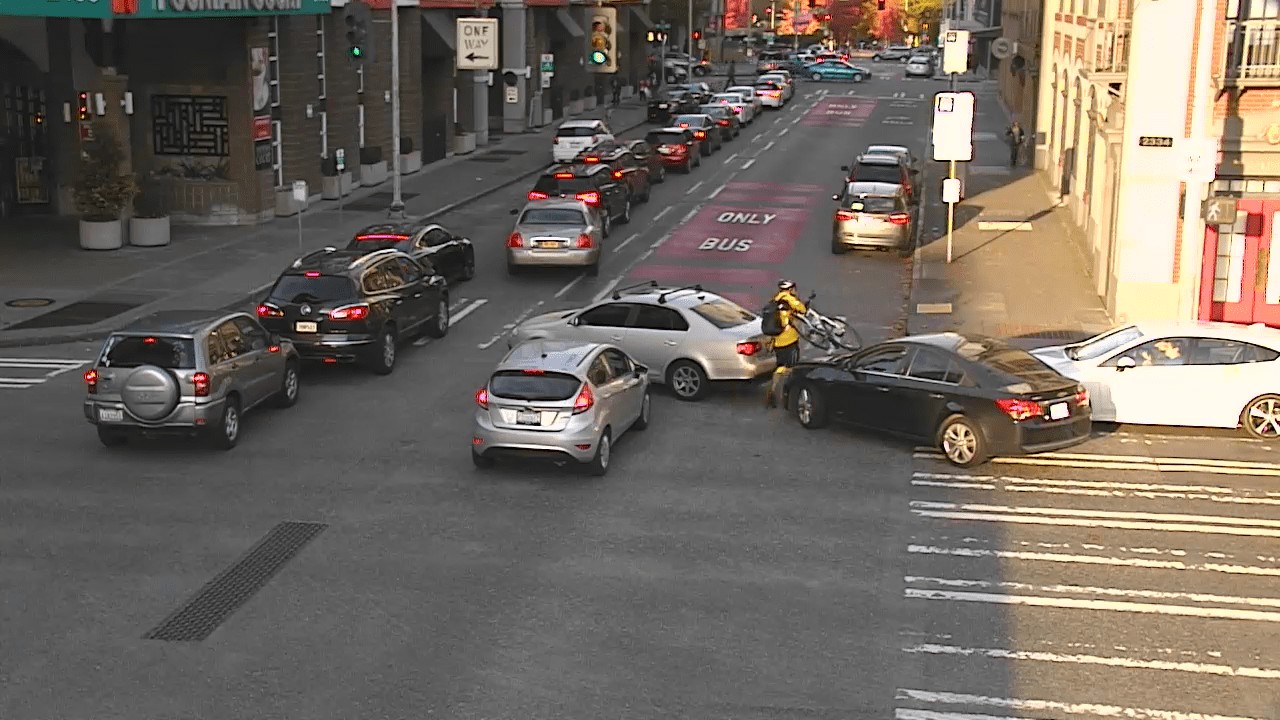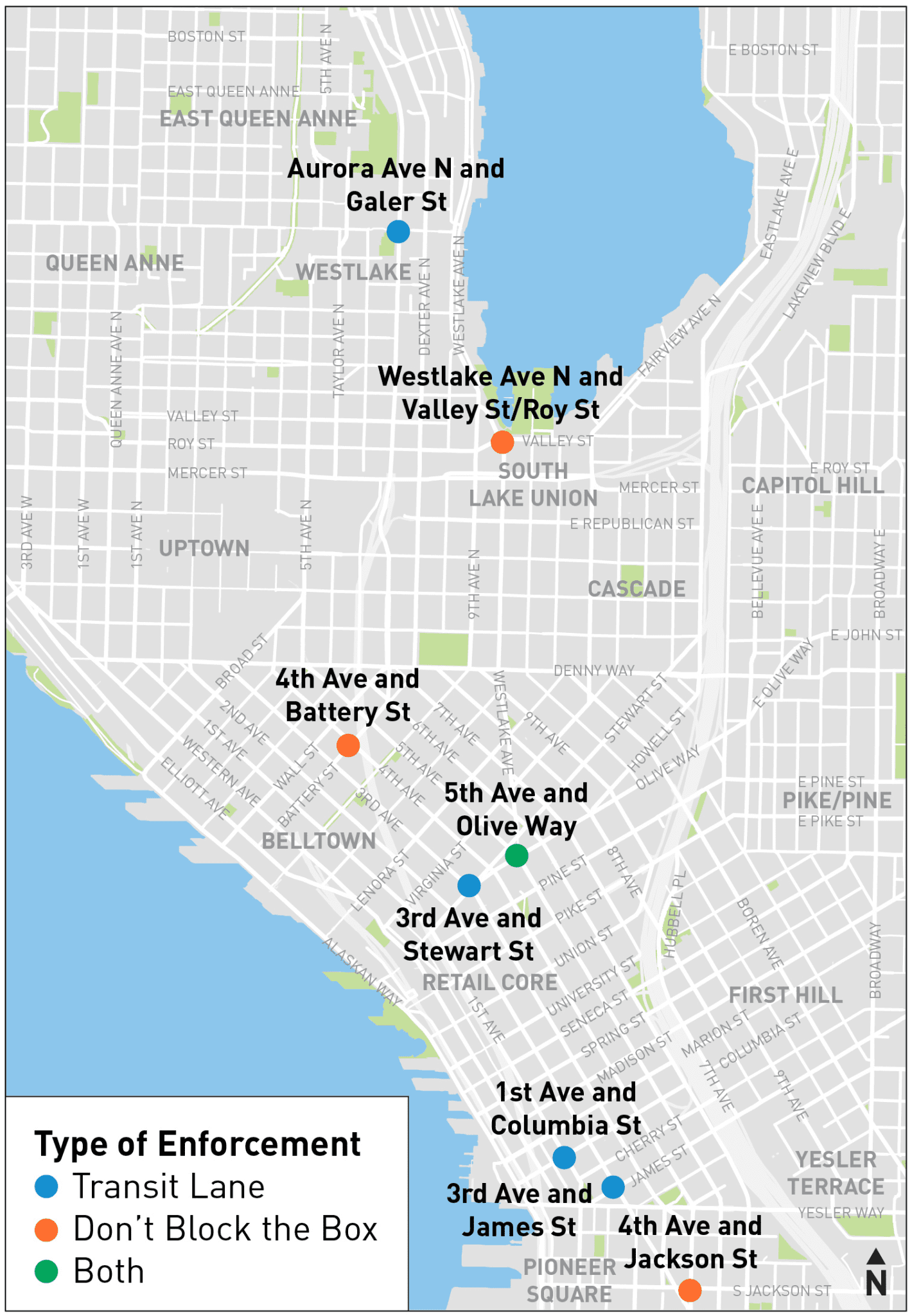 A graphic illustration reminding drivers to keep crosswalks and intersections clear by not entering the intersection when there's not a clear path across. Graphic: SDOT
A graphic illustration reminding drivers to keep crosswalks and intersections clear by not entering the intersection when there's not a clear path across. Graphic: SDOT Update March 28, 2024: This blog post was originally posted in November 2021 and has been updated with the latest information.
Update (March 2024)
Block the box traffic safety camera at the follow locations will be activated on April 8, 2024.
- Boren Avenue and Howell Street
- Denny Way and Stewart Street and Yale Street
Once activated, the new traffic camera will photograph the license plates of vehicles illegally enter the intersection after the light turns red. The first time someone is caught in a violation, they will be mailed a warning letter. For any new violations after that, they will be mailed a $75 ticket.
Update (December 2023)
The transit lane traffic safety camera on the West Seattle Bridge (high bridge), just east of State Route 99, has been activated. The new traffic camera will photograph the license plates of vehicles illegally entering the transit lane. The first time someone is caught in a violation, they will be mailed a warning letter. For any new violations after that, they will be mailed a $75 ticket.
Installation of block the box traffic safety cameras at the following intersections has been delayed due supply chain issues and other street improvement work being undertaken:
- Boren Avenue and Howell Street
- Denny Way and Stewart Street and Yale Street

Update (August 2023)
SDOT and SPD have identified three locations for additional cameras as part of the automated enforcement pilot program evaluating cars illegally driving in bus-only lanes or blocking crosswalks and intersections. The new cameras will allow the city to collect a larger data set for a more robust analysis of the impact and effectiveness of these types of automated enforcement programs.
The city expects to install the cameras at the three identified locations at the beginning of September. There will be a 30-day warning period to ensure the public has adequate notice to learn the rules of the road.
- A transit lane enforcement camera will be installed on the West Seattle Bridge (high bridge), just east of State Route 99, to monitor the bus lane to prevent people from illegally driving where they are not allowed.
- Block the box enforcement cameras will be installed at two intersections to prevent people driving from blocking crosswalks and intersections after the light turns red: Boren Ave and Howell St and the three-way intersection of Denny Way and Stewart St and Yale Street.
Update (May 2022)
This blog post was originally posted in November 2021 and has been updated with the latest information. SDOT has activated all of the traffic cameras as listed in this blog post and shown in the map below.
Original Post (November 2021)
The Seattle Department of Transportation (SDOT) and Seattle Police Department (SPD) have turned on new traffic cameras which take photos of cars that are illegally driving in bus-only lanes, or blocking crosswalks and intersections. These cameras are expected to help improve public safety, reduce congestion, keep transit moving, and increase mobility for people with disabilities.
The new traffic cameras photograph the license plates of vehicles violating the law. The first time someone is caught in a violation, they will be mailed a warning letter. For any new violations after that, they will be mailed a $75 ticket.
Activated camera locations:
- Aurora Ave N at Galer St (Transit Lane)
- 3rd Ave at Stewart St (Transit Lane)
- 5th Ave at Olive Way (Transit Lane & Crosswalk and Intersection Blocking)
- 3rd Ave at James St (Transit Lane)
- 1st Ave at Columbia St (Transit Lane)
- 4th Ave at Battery St (Crosswalk and Intersection Blocking)
- 4th Ave at Jackson St (Crosswalk and Intersection Blocking)
- Westlake Ave N at Valley St/Roy St (Crosswalk and Intersection Blocking)
All locations have clear signs and pavement markings, with white lines indicating where the intersection “box” begins, and road markings indicating lanes which are restricted to buses only.
The cameras are located in 8 locations in downtown Seattle, South Lake Union, Belltown, Pioneer Square, and State Route 99. These locations were chosen based on their history of problematic and ongoing violations of people blocking the intersection or driving in the transit lane.

The City began by turning on cameras which monitor bus lanes in five locations to prevent people from illegally driving where they are not allowed. This helps keeps buses moving, which in turn makes our transit system more reliable, benefiting everyone. Buses move more people at a time than individual cars, and every person taking a bus means one less car on the road, which is an incredibly important way to help address congestion and climate change for everyone.
The City then turned on cameras at four busy intersections to prevent people driving from blocking crosswalks and intersections after the light turns red (also known as “blocking the box”). It is illegal for drivers to enter an intersection unless they have a clear path to make it all the way through. This behavior is illegal and dangerous, increasing the risk of crashes and preventing people in crosswalks from safely crossing the street. This is especially dangerous for people with disabilities, as people who are blind, use wheelchairs, or have other mobility needs can get stuck in harm’s way in the middle of the street with no safe way back to the sidewalk. Blocking the box also increases congestion, preventing people from moving and bringing traffic to a standstill.
Traffic Enforcement Camera Locations

SDOT announced the new camera locations and installed signs in November 2021 to make sure people had time to learn the rules of the road and avoid receiving tickets. SDOT has published this announcement in 10 languages, and will continue to share reminders on social media, with community based organizations, and through public service announcements.
Under state law, half of the net revenue from the traffic cameras will go to a Washington Traffic Safety Commission fund for bicycle, pedestrian and non-motorized safety projects, and the other half of the net revenue must be used to build safety and mobility improvements for people with disabilities in Seattle. SDOT plans to invest this in building more accessible walk signals which vibrate and make a noise to let people with limited vision or hearing know when it is safe to cross the street.
The cameras will work like photo-enforcement cameras in other parts of Seattle which issue tickets for red light violations or speeding in school safety zones. This will mean fewer police officers making in-person traffic stops, so that police can focus on other public safety needs. This also makes enforcement more consistent, objective, and fair.
To protect privacy, the cameras will only record vehicle license plates and not the people inside the car. The photos are only intended to be used for enforcing the bus lane and blocking the box laws, and are not intended for other law enforcement action.